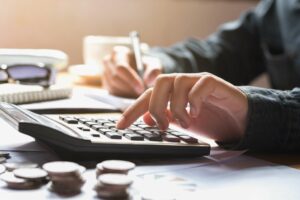Understanding Accumulated Depreciation: Definition, Calculation, and Examples

Instead, the balance sheet might say “Property, plant, and equipment – net,” and show the book value of the company’s assets, net of accumulated depreciation. In this case, you may be able to find more details about the book value of the company’s assets and accumulated depreciation in the financial statement disclosures. Accumulated depreciation should be shown just below the company’s fixed assets. The accumulated depreciation of an asset is the amount of cumulative depreciation that has been charged on the asset from its purchase date until the reporting date. It is a contra-account, which is the difference between the asset’s purchase price and its carrying value on the balance sheet and is easily available as a line item under the fixed asset section on the balance sheet.
- The book value starts at the acquisition value and then is recalculated every year after the depreciation expense is taken.
- The difference between accumulated depreciation and the asset’s original cost gives the asset its book or carrying value.
- While the depreciation expense is the amount recognized each period, the accumulated depreciation is the sum of all depreciation to date since purchase.
- To demonstrate this, let’s assume that a retailer purchases a $70,000 truck on the first day of the current year, but the truck is expected to be used for seven years.
- Whether machinery, a vehicle, or furniture, the item will eventually wear out or become outdated.
- The machinery is expected to have a useful life of 5 years, after which it will have no residual value.
Accumulated Depreciation and the Balance Sheet
Accumulated depreciation is the total sum of all depreciation expenses recorded for a specific asset since it was first put into use. It’s a contra-asset account on the balance sheet that reduces the gross value of fixed assets to reflect their declining value over time. The accumulated depreciation account is an asset account with a credit balance (also known as a contra asset account). If this derecognition https://www.bookstime.com/ were not completed, a company would gradually build up a large amount of gross fixed asset cost and accumulated depreciation on its balance sheet. A journal entry to record depreciation in a company’s general ledger has two parts.
📆 Date: Aug 2-3, 2025🕛 Time: 8:30-11:30 AM EST📍 Venue: OnlineInstructor: Dheeraj Vaidya, CFA, FRM
Straight-line depreciation is the most straightforward and commonly used method. It divides the asset’s depreciable base (cost minus salvage value) evenly across its useful life and assumes that its value declines steadily over time. Common sense requires depreciation expense to be equal to total depreciation per year, without first dividing and then multiplying total depreciation per year by the same number. Cost generally is the amount paid for the asset, including all costs related to acquiring and bringing the asset into use.7 In some countries or for some purposes, salvage value may be ignored. The rules of some countries specify lives and methods to be used for particular types of assets.
Sum-of-the-Years’ Digits (SYD) Method
To calculate net book value, subtract the accumulated depreciation and any impairment charges from the initial purchase price of an asset. After three years, the company records an asset impairment charge of $200,000 against the asset. This means that the asset’s net book value is $500,000 (calculated as $1,000,000 purchase price – $200,000 impairment charge – $300,000 accumulated depreciation). Accumulated depreciation is the sum of all depreciation expenses taken on an asset since the beginning of time. Once you calculate the depreciation expense for each year, add the years’ depreciation accumulated depreciation meaning expense together until you get to the point at which you want to calculate accumulated depreciation. Accumulated depreciation is a contra-asset account that appears on the asset section of the balance sheet.
How to calculate accumulated depreciation in accounting
The business can account for this loss through accumulated depreciation, which helps tie the cost of using long-term assets to the income they help generate over time. The double-declining-balance method, or reducing balance method,11 is used to calculate an asset’s accelerated rate of depreciation against its non-depreciated balance during earlier years of assets useful life. Depreciation ceases when either the salvage value or the end of the asset’s useful life is reached. Most businesses calculate depreciation and record monthly journal entries for depreciation and accumulated depreciation.
Taxable Income Reduction
- As defined before, accumulated depreciation is the total amount of a company’s cost that has been allocated to depreciation expense since the asset was put into use.
- From an accounting standpoint, the depreciation expense is debited, while the accumulated depreciation is credited.
- To introduce the concept of the units-of-activity method, let’s assume that a service business purchases unique equipment at a cost of $20,000.
- This shows the asset’s net book value on the balance sheet and allows you to see how much of an asset has been written off and get an idea of its remaining useful life.
- Depreciation is an expense on the income statement whereas the accumulated depreciation is a contra asset recorded on the balance sheet.
- Deciding on the right depreciation method for your assets can be as strategic as choosing the right chess move.
- This is because it functions as a contra-asset account, essentially a negative asset account that offsets the value of the related fixed asset.
Assets have economic value that benefit the company over multiple accounting periods. It is also not a liability because it does not represent an obligation to pay a third party. It is a contra-asset account however, so it appears on the balance sheet in the asset section.
What is the Role of Accumulated Depreciation in Financial Statements?
Debit your Depreciation Expense account $1,000 each month and credit your Accumulated Depreciation account $1,000. GAAP encompasses a set of standards that govern the intricacies, complexities, and… The equipment has a useful life of 5 years, therefore, the cost of the equipment should be distributed across 5 years of its use. In addition, it provides a depreciation schedule as well as the opportunity to assets = liabilities + equity share your calculations on social media.




